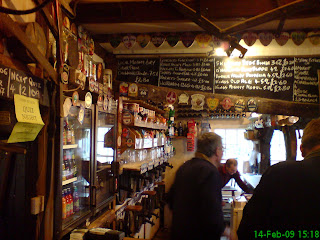


Harvey's Sussex Best has always been one of my favourite beers. I can't remember where and when I first sampled it, but it was a long time ago. To me it has that perfect balance between sweet juicy malt, and an earthy, peppery hop bitterness. At 4.0% abv, it's just the right strength for a good session's drinking, being full-bodied but not too strong in alcohol to make one fall over after four or five pints.
I'm lucky living in an area of Kent that borders onto Sussex. Harvey's won't supply pubs that are much outside a fifty mile radius of their home town of Lewes, preferring to keep things on a local scale as much as possible. Although there aren't any Harvey's tied houses in Tonbridge, the majority of the town's pubs sell the company's Best Bitter. They have to, as such is the beer's popularity amongst local drinkers, that trade would suffer in a pub that was foolish enough not to sell it.
Harvey's wasn't always the drink of choice of local drinkers; not because there used to be something wrong with it, but simply because it just wasn't available to landlords tied to the old pub empires of Charrington, Courage and Whitbread. Now that these companies no longer dominate the local trade, Harvey's have moved in, selling their beer through the likes of Enterprise and Punch. The situation has almost now reached a stage where familiarity breeds contempt so that when I enter a local pub and see the Harvey's pump, I am often tempted to try something else, purely by way of a change.
Last week I attended a CAMRA social held at a Harvey's tied pub; the Two Brewers in Hadlow. After nearly freezing to death at a cold and draughty bus stop, waiting for a bus that was at least 15 minutes late, my companions and I were glad of the welcoming warmth that greeted us when we finally stepped inside the pub. There were three ales on offer that night: Dark Mild, Hadlow Bitter and Sussex Best. Now I've never been a huge fan of mild, and although the Harvey's version is not bad when on form, I gave this beer a miss - almost without thinking. (I was glad I did, as those of our group that did try it, found it to be past it's best).
The second beer - Hadlow Bitter, is just the former PA re-badged; something that was ironically enough carried out when Harvey's first acquired the former Fiddling Monkey in Hadlow, and renamed it the Two Brewers, in honour of the substantial brewery (Kenward & Court - taken over and closed by Charringtons during the late 1940's), that once stood in this pleasant Kent village. According to Harvey's, PA was first introduced during the Second World War when, owing to brewing ingredients being rationed, it was necessary to brew a lower strength beer. At 3.5% abv, it is a good lunchtime pint, but on a freezing cold early March night I wanted something with a bit more oomph in it!
Harvey's Sussex Best therefore fitted the bill perfectly. Furthermore the beer was in absolute tip-top condition. It was so good that I stuck to it for the rest of the evening, even remaining on it when we got back to Tonbridge and popped into Mojo's (close to the station for those who had trains to catch), for a couple of final pints. As the title of this post says "you can't beat an old friend", and sometimes it is good to return to an old favourite. This was certainly the case the other night, and proved to me just what I had been missing.















